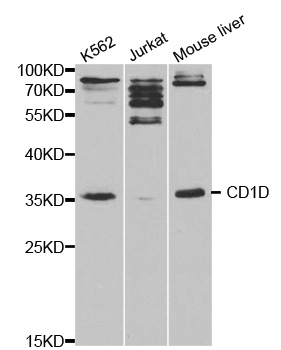CD1d antibody [N2C3]
GTX104898
ApplicationsWestern Blot
Product group Antibodies
TargetCD1D
Overview
- SupplierGeneTex
- Product NameCD1d antibody [N2C3]
- Delivery Days Customer9
- Application Supplier NoteWB: 1:500-1:3000. *Optimal dilutions/concentrations should be determined by the researcher.Not tested in other applications.
- ApplicationsWestern Blot
- CertificationResearch Use Only
- ClonalityPolyclonal
- Concentration0.91 mg/ml
- ConjugateUnconjugated
- Gene ID912
- Target nameCD1D
- Target descriptionCD1d molecule
- Target synonymsCD1A, R3, R3G1, antigen-presenting glycoprotein CD1d, CD1D antigen, d polypeptide, HMC class I antigen-like glycoprotein CD1D, T-cell surface glycoprotein CD1d, differentiation antigen CD1-alpha-3, thymocyte antigen CD1D
- HostRabbit
- IsotypeIgG
- Protein IDP15813
- Protein NameAntigen-presenting glycoprotein CD1d
- Scientific DescriptionThis gene encodes a divergent member of the CD1 family of transmembrane glycoproteins, which are structurally related to the major histocompatibility complex (MHC) proteins and form heterodimers with beta-2-microglobulin. The CD1 proteins mediate the presentation of primarily lipid and glycolipid antigens of self or microbial origin to T cells. The human genome contains five CD1 family genes organized in a cluster on chromosome 1. The CD1 family members are thought to differ in their cellular localization and specificity for particular lipid ligands. The protein encoded by this gene localizes to late endosomes and lysosomes via a tyrosine-based motif in the cytoplasmic tail. [provided by RefSeq]
- Storage Instruction-20°C or -80°C,2°C to 8°C
- UNSPSC12352203
References
- Zerumbone modulates CD1d expression and lipid antigen presentation pathway in breast cancer cells. Shyanti RK et al., 2017 Oct, Toxicol In VitroRead more






